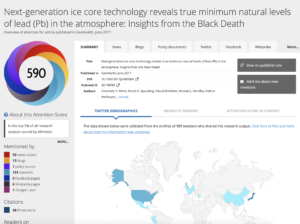Top 5% of all research outputs scored by Altmetrics: AGU journal article: The Impact of a Six-year Climate Anomaly on the ‘Spanish Flu’ Pandemic and WWI – More, Loveluck, Clifford, Handley, Korotkikh, Kurbatov, McCormick and Mayewski

The Impact of a Six-Year Climate Anomaly on the “Spanish Flu” Pandemic and WWI
Abstract
The H1N1 “Spanish influenza” pandemic of 1918–1919 caused the highest known number of deaths recorded for a single pandemic in human history. Several theories have been offered to explain the virulence and spread of the disease, but the environmental context remains underexamined. In this study, we present a new environmental record from a European, Alpine ice core, showing a significant climate anomaly that affected the continent from 1914 to 1919. Incessant torrential rain and declining temperatures increased casualties in the battlefields of World War I (WWI), setting the stage for the spread of the pandemic at the end of the conflict. Multiple independent records of temperature, precipitation, and mortality corroborate these findings.
Plain Language Summary
A new, high-resolution climate record from Europe shows a once-in-a-century climate anomaly that occurred during the years of World War I and the Spanish flu pandemic. Mortality data from all causes show increases in times of worsening weather, precipitation, and temperatures, a factor in many of the major battles of WWI, as well as a possible exacerbating factor for the virulence of the pandemic.
https://agupubs.onlinelibrary.wiley.com/doi/epdf/10.1029/2020GH000277

